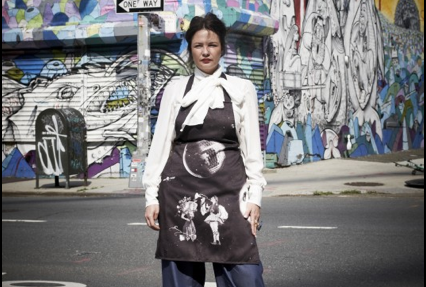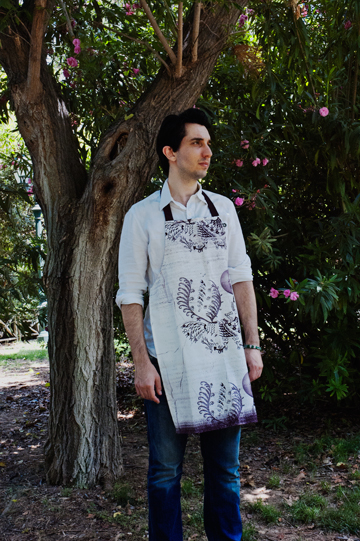POSTFOLK is the work of Maria-Olga Vlachou and Kostis Vassiliadis, two Greek graphic designers who have become intrigued by the design potential of the motifs in Greek folk art.
These motifs have formed part of the graphical lexicon of traditional Greek culture for many generations, but are now an object of mostly curatorial or antiquarian interest. POSTFOLK works to relocate these elements within a new visual context and physical form, most of all in the pure brilliant colors of silk-screen prints.
Postfolk. The name alone takes us into the past, though we find something rather futuristic seeing your design aesthetics. What is the concept behind this project?
POSTFOLK is the future of our past. It’s the evolution of the tools we inherited through the folk art of our Greek Heritage, or rather our version of what that evolution is. POSTFOLK is a postmodern take on Greek folk art, and it’s based on embroidered motifs encountered on traditional garb, throws and other textiles. It is much more than that though—the basis of our design concept is based on the deconstruction of these motifs and the creation of a new identity. We digitally “embroider” these motifs anew in or own unique way, and this process in itself makes them futuristic.
You come from an advertising background. How does this kind of experience play a part in the steps that Postfolk makes in design and fashion?
Coming from an advertising background gives us an ease in moving from concept to execution. As graphic designers, we have ample branding experience and from the start we felt quite comfortable translating our vision into reality. We had the story, we created the connection to the present, we constructed the bridge to the future and we manufactured a mythology around POSTFOLK. The culmination of it all was the first POSTFOLK product line, called DISCOFOLK, which provided the bricks and mortar for the whole project.
What is the source of your inspiration exactly? Which retro and folk elements do you present in your work?
Our source of inspiration can be anything that invokes the era of folk traditions, the ornamental marks of organic decoration, people, animals— that have been woven by loom or by hand. Examples of such folk art are found in museums featuring traditional/folk art, in rural homes, as artifacts passed down through the generations, etc. What is most extraordinary is how visually compelling the colors of the yarns used and combinations still are.
You focus on traditional Greek motifs. This is obvious for someone that hails from Greece. Are there any other cultures that inspire you to integrate them into your designs?
Originally, Greek Folk Art inspired our premise, but as we continued to work on our concept, we found many mutual factors between the traditional culture of Greece and other countries. Many of the symbols used in folk embroidery are common across many cultures— trees and flora, birds, polymorphic animals are all part of an international language of symbols used. The way these symbols transport into present use differs though. For example, Scandinavian countries, with their elaborate designs, constantly reinvent their art and adapt it to the present. We aspire to do the same using a futuristic perspective, by rendering it anew!
In the process of making our first product line, DISCOFOLK, we incorporated references from a completely different era and country. Mixing the disco ball, the go-to symbol of 70’s era pop-culture and of the legendary NYC nightclub scene, with the art of our grandmothers’ makes for something very interesting indeed.
What material do you prefer to work with the most and in which design field do you specialize?
Call it a vocational hazard, but paper is the medium we’ve always seen our work on and the medium we have the most familiarity with. Initially we used digital printing on paper while also trying out new mediums, like Tyvek paper that’s a paper constructed to have many of the same qualities as plastic. What’s interesting to us is that we can utilize any printable surface, so we continually seek out new mediums and explore all kids of possibilities.
Aprons! Designer aprons. These designs are so unique that they have somewhat become your trademark. It is a rather difficult/niche market item though. How did u come up with the idea?
Yes, designer aprons! DISCOFOLK in the kitchen! The idea for using new or innovative mediums was a part of POSTFOLK from the beginning. We found the right sources and the idea became a reality. This means you can count on seeing more unique product designs for everyday use from us in the future. The apron has always been the symbol of the “housewife”, a symbol embedded in Greek culture and in the global traditions of opening ones’ home and “hospitality”. After all, it’s in our blood so it was impossible to work around it!
Where can one find Postfolk?
POSTFOLK’s digital art prints and Tyvek placemats can be found for sale at the Eleni Marneri Galerie online site, elenimarneri.com, and our DISCOFOLK aprons can be bought at xombli.com, a site dedicated to showcasing the products of high profile and up-and-coming designers.
You are a bonded team of two, even though you live apart. As for your goals, are you optimistic about the future? Is Greece your target market or do you wish to expand the label internationally?
Our goal is to promote POSTFOLK in the international marketplace while pushing traditional folk art back onto the world stage of art and design. By looking back into our past we find answers to our present and a direction for our future. We don’t want POSTFOLK to be limited to the nostalgia of Greece’s new generation, but rather to be relevant to all cultures that have some link to their folk art. Our motto is that, as William Morris (English textile designer, artist, writer, and libertarian) says, “Whatever is unhappy is immoral”. We are really optimistic about the future of Greek design in the international marketplace and we like to think of ourselves as the “guardians of tradition”.
Interview: Nelly Skoufatoglou
Photos: Manos Katsaprinis (Athens), Nicholas A.Prakas (N.Y.)






